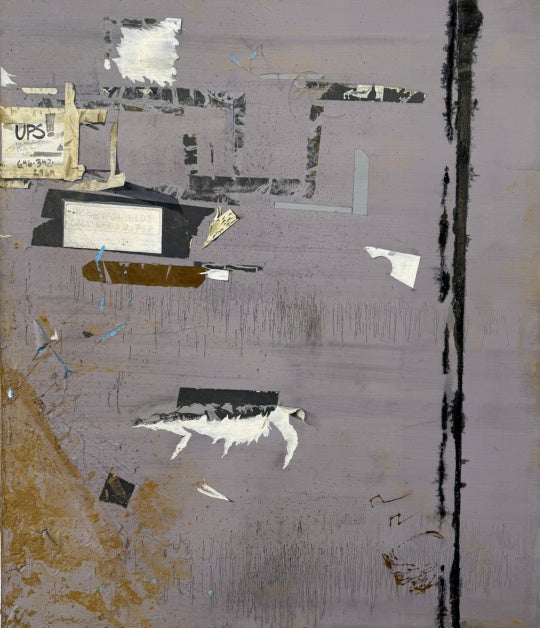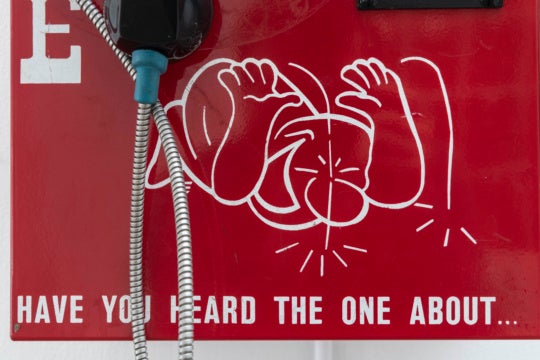
Despite the many majestic works he created during his short career, the art of Ronald Lockett (1965-1998) has long been overshadowed, either by the fame of his better known cousin Thornton Dial or by the specter of the AIDS-related pneumonia that caused his death in 1998 at the age of 32. Lockett—who lived his entire life in Bessemer, Alabama, never moving out of his mother’s house—is by no means the first artist to have the quality of his work eclipsed in the public imagination by details of his biography, and it would be unwise to dismiss Dial’s artistic mentorship or the tragedy of Lockett’s early death from a thorough consideration of his career. The unfortunate consequence of these looming presences in Lockett’s story, however, is that until recently his work was given little space and time to speak for itself.
On view at the High Museum through this Sunday, January 8, “Fever Within: The Art of Ronald Lockett” aspires to grant Lockett’s work this overdue opportunity. While the exhibition admirably attempts to place the focus on Lockett’s artwork instead of his biography, this proves to be too sharp an overcorrection: ultimately there is too much work for the space, causing the artwork to overshadow itself. Regarding his materials, subject matter, and imagery, the development of Lockett’s distinctive artistic vocabulary is apparent throughout “Fever Within,” but the exhibition makes confusingly little effort to organize the art accordingly. For some exhibitions chronology can be a curatorial crutch too quickly leaned upon, but in this instance it would have provided a clear narrative trajectory well matched with the developments in Lockett’s work over the decade in which he was most prolific. Instead of leading the viewer through the evolution of Lockett’s techniques and artistic vision, the arrangement of the artwork in “Fever Within” is disorienting from the start.

The opening gallery is dominated by the rusted metal pieces Lockett created between 1992 and 1994, in which he subtly shaped the silhouettes of animals such as wolves, beavers, and deer out of sheets of metal. As these works are hung on the same wall as the entrance to the gallery, attending to them requires the viewer to turn around immediately upon entering, interrupting a natural sense of progression through the exhibition. As striking as these pieces are, their unique place within Lockett’s body of work—between his early assemblages of nails, wood, and cloth and the complex, colorful metal tapestries he made in the years just before his death—is glossed over by the relative lack of context they are afforded.

Beside these metal pieces, an entire wall is given over to an enlarged photo of Lockett himself, appearing shy and sensitive even in a snapshot. While it is poignant to see the artist’s image amid his work, this ultimately feels like a waste of wall space that could have been used for pieces that are crammed tightly elsewhere. At multiple points throughout “Fever Within,” such as with the apocalyptic assemblages A Dream of Nuclear Destruction and Hiroshima, works are hung one above the other, overwhelming the viewer and suffocating the artwork. Additionally, this portrait feels like an indulgent moment of emphasizing the pathos of Lockett’s story over the artwork he created. Along these same lines, the sounds of a video about Lockett’s life echo through the galleries, a distraction that feels like a pesky pop-up ad that has been substituted for wall text.

The most illuminating piece of Lockett’s early work is tucked in the one of the back corners of the far gallery. In Rebirth, nails and wire form the skeletal figure of an unidentifiable animal proceeding from right to left across Masonite hardboard, passing from the blue and green of life into death’s darkness. It’s hard not to see Rebirth as the fertile seed from which the rest of Lockett’s most powerful work blossomed; already present in this 1987 piece are his most persistent images and ideas: animals struggling to survive, death and destruction, the absurdity of suffering. The skeletal figure appears again encircled in black in A Place in Time, the 1989 assemblage Rebirth hangs beside at the High. A Place in Time demonstrates much more material dexterity and formal inventiveness than Rebirth, integrating the figure of a buck deer trapped in a net along with smaller vignette-like scenes framed in cloth, but together they are clear articulations of the first phases of Lockett’s artistic development.

For someone so easily relegated to rural Alabama by an overemphasized biography, Lockett was a remarkably keen, empathetic observer of history and contemporary issues. In 1988, Lockett depicted 20th-century events including the Holocaust, the bombing of Hiroshima, and the Civil Rights movement, and created works titled Poison River and Out of Ashes. As Lockett began developing his early artistic vocabulary through these works, moving from the simple nail figure in Rebirth to incorporate pieces of metal and plastic on abstractly painted wood, his attention was also turned to the violence and tragedy of the world. His Traps series, made up of assemblages that depict buck deer and other creatures snared in sections of fencelike wire, have been interpreted as Lockett’s response to the mass incarceration of young black men during the 1980s and ’90s. He displayed this compassionate attentiveness again in 1995 by creating the Oklahoma series following the Oklahoma City bombing. These four pieces, in which Lockett layers rusted sheets of metal and wire to evoke the appearance of a demolished building, demonstrate further developments of the techniques he used to form the rusted metal pieces that appear in the first gallery. Piecing together this relationship is left to the viewer, however, since the Oklahoma series is situated on the back wall of a side gallery, far from its precedents at the exhibition’s entrance.

In the final years of his life, Lockett continued working with sheet metal in innovative ways. In the spare, poetically simple Once Something Has Lived It Can Never Really Die, Lockett reduces the imagery of his Traps series to its most basic components, almost blending the figure of a deer into the patina of the metal sheet behind it. The artist’s final creative stride with sheet metal led him to utilize layers of brightly painted tin, an unexpected delight given the dull rusty hues of his earlier metal pieces. England’s Rose, Lockett’s 1997 tribute to Princess Diana, was created the same year as Sarah Lockett’s Roses, in which the artist remembered the beloved great-grandmother who raised him. Clearly both works share imagery of roses and honor women who Lockett admired, but they are also among the most mature, fully realized executions of his distinctive materials and methods in the exhibition, incorporating intricately layered sheets of painted tin to fashion colorful metallic tapestries.

Together England’s Rose and Sarah Lockett’s Roses represent the culmination of Lockett’s formal endeavors with sheet metal, but they also demonstrate the fierce compassion he felt for the world past and present, near and far. This compassion, which fuels Lockett’s need to address the suffering of the world through art, is the true fever within, despite the tempting medical interpretations of the title. Though chronological arrangement of artwork can come off as pedantic or boring, such an approach would have provided a clearer path through Lockett’s artistic development and given “Fever Within” the final moment it deserves, showcasing England’s Rose and Sarah Lockett’s Roses alongside each other. Together they represent the triumph of Lockett’s inventiveness as well as his expansive emotional acuity: a metallic rose garden ablaze with color and feeling.
Logan Lockner is Assistant Editor of BURNAWAY, as well as a contributor to publications including Art Papers and Photograph.




